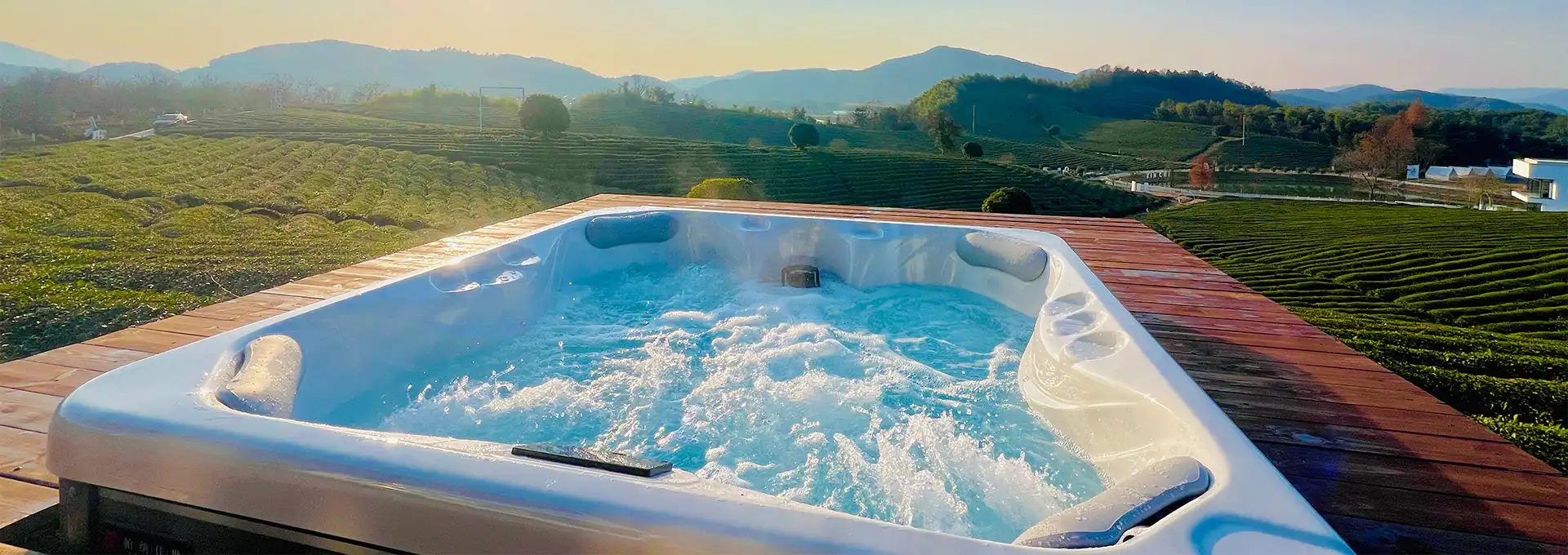How Thick of Concrete for Hot Tub?
2025-04-28 10:18:43
When it comes to installing an outdoor hot tub, one of the most crucial considerations is the concrete foundation. The thickness of the concrete slab plays a vital role in ensuring the stability, longevity, and safety of your hot tub. This blog post will explore the factors that determine the ideal concrete thickness for your outdoor hot tub, as well as provide insights into proper installation techniques and maintenance tips.
What factors affect the required concrete thickness for an outdoor hot tub?
Hot Tub Size and Weight
The size and weight of your outdoor hot tub are primary factors in determining the necessary concrete thickness. Larger hot tubs with higher water capacities naturally exert more pressure on the foundation, requiring a thicker concrete slab. For instance, a small two-person hot tub may only need a 4-inch thick concrete pad, while a large eight-person hot tub could require a 6-inch or even 8-inch thick slab. It's essential to consider not only the empty weight of the hot tub but also the additional weight of water and occupants. A typical outdoor hot tub can weigh anywhere from 3,000 to 6,000 pounds when filled, so the concrete foundation must be able to support this substantial load without cracking or settling.
Soil Conditions
The soil conditions at your installation site play a crucial role in determining the appropriate concrete thickness for your outdoor hot tub. Different soil types have varying load-bearing capacities and stability characteristics. For example, clay soils tend to expand and contract with moisture changes, which can lead to foundation shifts. Sandy soils, on the other hand, may be more prone to erosion. In areas with poor soil conditions, you may need to increase the concrete thickness or even consider additional reinforcement measures such as a deeper foundation or the use of steel rebar. It's always advisable to consult with a local contractor or structural engineer who is familiar with the soil conditions in your area to ensure that your outdoor hot tub's concrete foundation is adequately designed for the specific site conditions.
Climate and Weather Conditions
The climate and weather conditions in your region can significantly impact the required concrete thickness for your outdoor hot tub installation. Areas prone to freeze-thaw cycles, for instance, may require thicker concrete to prevent cracking and damage caused by the expansion and contraction of water within the slab. In regions with extreme temperature fluctuations, it's crucial to use concrete mixes specifically designed to withstand these conditions. Additionally, areas with high rainfall or potential flooding may benefit from a slightly elevated concrete pad to prevent water accumulation around the hot tub. When planning your outdoor hot tub installation, consider the local climate and consult with professionals to determine the optimal concrete thickness and mix design to ensure long-term durability and performance.
How do you properly prepare the site for pouring concrete for an outdoor hot tub?
Site Excavation and Leveling
Proper site preparation is crucial for ensuring a stable foundation for your outdoor hot tub. Begin by excavating the area to a depth that accommodates both the concrete thickness and a layer of compacted gravel. This gravel base helps with drainage and provides a stable surface for the concrete. Use a laser level or transit to ensure the excavated area is perfectly level, as even slight inconsistencies can lead to problems with your hot tub's stability. Remove any organic material, such as grass or roots, and compact the soil thoroughly. If you encounter any soft spots or areas of poor soil quality, consider removing and replacing them with compacted fill material. Remember that the excavated area should extend beyond the footprint of your outdoor hot tub by at least 6 inches on all sides to provide adequate support and room for forms.
Formwork and Reinforcement
Once the site is excavated and leveled, it's time to set up the formwork for your concrete pad. Use sturdy wooden boards or metal forms to create a perimeter that matches the desired dimensions of your outdoor hot tub foundation. Ensure that the forms are straight, level, and securely anchored to prevent bulging or movement during the concrete pour. For additional strength and crack resistance, consider incorporating steel reinforcement into your concrete slab. This typically involves laying a grid of steel rebar or wire mesh across the area before pouring the concrete. The reinforcement helps distribute the weight of the hot tub more evenly and reduces the risk of cracking due to settlement or temperature changes. Be sure to elevate the reinforcement slightly off the ground using concrete spacers to ensure it's properly embedded within the slab.
Concrete Mix and Pouring Techniques
Choosing the right concrete mix is essential for creating a durable foundation for your outdoor hot tub. Opt for a high-strength concrete mix with a minimum compressive strength of 3,000 psi (pounds per square inch). Consider adding fiber reinforcement to the mix for improved crack resistance. When pouring the concrete, use proper techniques to ensure even distribution and proper consolidation. Start from one corner and work your way across the slab, using a screed board to level the surface as you go. Use a bull float to smooth the surface and remove any air pockets. For larger slabs, you may want to use a power trowel to achieve a smooth, professional finish. Allow the concrete to cure properly, which typically takes about 28 days for full strength. During this time, keep the slab moist by periodically spraying it with water or covering it with plastic sheeting to prevent rapid drying, which can lead to cracking.
What maintenance is required for a concrete pad supporting an outdoor hot tub?
Regular Inspections and Cleaning
Maintaining the concrete pad supporting your outdoor hot tub is crucial for ensuring its longevity and performance. Conduct regular inspections of the concrete surface, looking for any signs of cracking, chipping, or settling. Pay close attention to the areas around the hot tub, where water spillage is most likely to occur. Clean the concrete pad regularly to prevent the buildup of dirt, algae, or mildew, which can make the surface slippery and potentially dangerous. Use a pressure washer or a stiff-bristled brush with a mild detergent solution to clean the surface thoroughly. Avoid using harsh chemicals that could damage the concrete or affect the pH balance of your hot tub water. If you notice any stains from chemicals or organic matter, address them promptly using appropriate cleaning methods to prevent long-term discoloration or damage to the concrete surface.
Sealing and Waterproofing
To protect your concrete pad from water damage and extend its lifespan, consider applying a high-quality concrete sealer. This is particularly important for outdoor hot tub installations, as they are constantly exposed to moisture and potentially harsh weather conditions. A good sealer will help prevent water absorption, reduce the risk of cracking due to freeze-thaw cycles, and make the surface easier to clean. Depending on the type of sealer used and the amount of foot traffic around your outdoor hot tub, you may need to reapply the sealer every 1-3 years. In addition to sealing, pay attention to the joints between the concrete pad and any adjacent structures, such as your home's foundation or decking. Use a flexible, waterproof caulk to seal these joints and prevent water from seeping underneath the concrete, which could lead to erosion or settling over time.
Addressing Cracks and Damage
Despite your best efforts, cracks or damage may occasionally occur in the concrete pad supporting your outdoor hot tub. It's essential to address these issues promptly to prevent them from worsening and potentially compromising the stability of your hot tub. For small hairline cracks, use a high-quality concrete crack filler or epoxy injection system to seal the crack and prevent water infiltration. Larger cracks or areas of significant damage may require more extensive repairs, such as patching with a concrete repair mortar or, in severe cases, partial replacement of the affected area. If you notice any signs of settling or unevenness in your concrete pad, consult with a professional to determine the underlying cause and develop an appropriate solution. This may involve mudjacking to lift and level the slab or, in extreme cases, complete replacement of the concrete pad. Regular maintenance and prompt attention to any issues will help ensure that your outdoor hot tub remains stable and secure for years to come.
Conclusion
Determining the appropriate concrete thickness for your outdoor hot tub is crucial for ensuring its stability, longevity, and safety. Factors such as hot tub size, soil conditions, and climate all play a role in this decision. Proper site preparation, including excavation, formwork, and reinforcement, is essential for creating a solid foundation. Regular maintenance, including inspections, cleaning, sealing, and prompt repair of any damage, will help preserve your concrete pad and protect your investment in your outdoor hot tub. By carefully considering these factors and following best practices for installation and maintenance, you can enjoy your outdoor hot tub with peace of mind for years to come.
For more information on hot tub installations and our products, please feel free to contact us at info@iparnassus.com.
References
- Smith, J. (2021). Concrete Foundations for Outdoor Spas and Hot Tubs. Journal of Residential Construction, 15(3), 45-52.
- Johnson, A. & Williams, R. (2020). Factors Affecting Concrete Thickness in Outdoor Applications. International Journal of Civil Engineering, 8(2), 112-128.
- Brown, M. (2019). Hot Tub Installation Guide: From Site Preparation to Final Setup. Home & Garden Publishing.
- Davis, L. (2022). Concrete Mix Design for Outdoor Spa Foundations. Concrete International, 44(5), 33-39.
- Thompson, K. & Garcia, E. (2018). Maintenance Practices for Concrete Pads Supporting Outdoor Hot Tubs. Journal of Pool and Spa Industry, 12(4), 78-85.
- Wilson, P. (2020). Climate Considerations in Outdoor Hot Tub Installation. Environmental Design Quarterly, 28(2), 156-163.
Send Inquiry
Related Industry Knowledge
- How Long Does a Swim Spa Take to Heat Up?
- Can All Hot Tubs Be Salt Water?
- How Thick Should Concrete Be for a Hot Tub?
- How to Drain a Swim Spa?
- How to Clean a Cloudy Hot Tub?
- How to Keep a 6 Person Swim Spa Clean?
- When Is the Best Time to Purchase a Hot Tub?
- How much does a 6 Person Hot Tub Weigh?
- Can I Drain My Hot Tub and Leave It Empty?
- How to drain swim spa?



